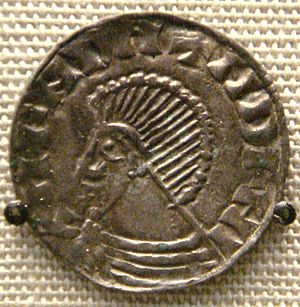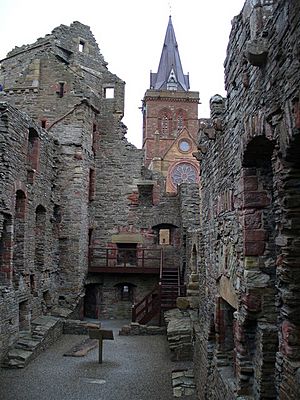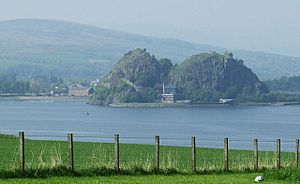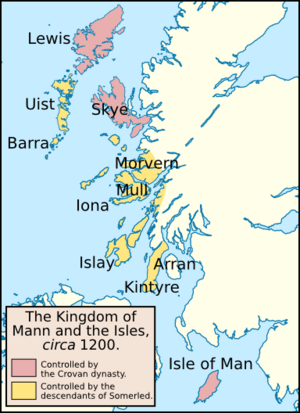List of rulers of the Kingdom of the Isles facts for kids
The Kingdom of the Isles was a group of islands that included the Hebrides, the islands in the Firth of Clyde, and the Isle of Man. This kingdom existed from the 800s to the 1200s AD. The Norse people called these islands the Suðreyjar, meaning "Southern Isles." This was to tell them apart from the Norðreyjar, or Northern Isles, which were Orkney and Shetland.
We don't have all the historical records, so the kingdom might not have been a continuous, single country for the whole time. Sometimes, people called it the "Kingdom of Mann and the Isles," but only some later rulers actually used that title. At times, the rulers were independent, meaning they didn't answer to anyone else. However, for much of the time, they had powerful overlords from Norway, Ireland, England, Scotland, or Orkney. Sometimes, different people also fought over who should control parts of the islands. These islands cover a large area, stretching over 500 kilometers (about 310 miles) from north to south.
Viking influence in the area began in the late 700s. The Uí Ímair family was very important during this early time. However, the exact dates and details about the rulers are mostly guesses until the mid-900s. There were often conflicts between the Kings of the Isles and the rulers of Ireland. Also, the King of Norway (or their powerful servants, the Earls of Orkney) often got involved in island affairs.
When Magnus Barelegs invaded in the late 1000s, Norway directly ruled the kingdom for a short time. But soon, the descendants of Godred Crovan took back control, and the islands were mostly independent again. This independence ended when Somerled rose to power. After Somerled died in 1164, the kingdom split into two parts. Just over a century later, in 1266, the islands became part of the Kingdom of Scotland after the Treaty of Perth.
The spelling of the rulers' names can be tricky because both Old Norse and Gaelic languages were spoken in the region for a long time. So, one person might be called Rognvaldr in Icelandic, Rag(h)nall in Gaelic, Reginaldus in Latin, and "Rognvald" or "Reginald" in English.
Contents
Early Viking Rulers (800s - early 900s)
During this time, historical records are very scarce, so these early entries are mostly based on guesses.
| Ruler of the Hebrides | Dates | Title | Notes |
|---|---|---|---|
| Unknown father of Thórir | 848 | King of Viking Scotland | According to the Orkneyinga saga, Rognvald Eysteinsson had sons, including Ivar and Thorir the Silent. Ivar died in battle during Harald Fairhair's trip west. Irish records say Thorir was the heir of a "Viking Scotland" king who took an army to Ireland in 848. |
| Gofraid mac Fergusa | d. 853 | Lord of the Hebrides | The Annals of the Four Masters calls him toisech Innsi Gall (leader of the Foreigners' Isles). |
| Gofraidh | pre 872–873 | King of Lochlann | Father of Amlaíb Conung and Ímar. |
| Ímar | 873 | King of the Norwegian Vikings of all Ireland and Britain | May have ruled briefly after his father. |
| Amlaíb Conung | 873 | King of the Northmen/King of the Western Sea | Ímar's brother. |
| Ásbjǫrn skerjablesi | 874 | ||
| Ketill Flatnose | c 890–900 | King of the Isles | The earliest clear writings about Ketill are from sagas written 200 years or more after he died. He probably didn't rule Mann and might have ruled in the mid-800s, not late. |
| Unknown | c 900–941 | Possibly ruled by Uí Ímair family members like Ragnall ua Ímair (died 920/1) who ruled Mann, Sitric Cáech (died 927), Gofraid ua Ímair (died 934), and Amlaíb mac Gofraid (died 941) as Kings of Dublin. |
Some historians think Eiríkr, who was King of York from 947–948 and 952–5, might have ruled in the islands at some point in the mid-900s.
Kings of Mann and the Isles (Late 900s - 1000s)

| Ruler of the Hebrides and Mann | Period of Rule | Title | Notes |
|---|---|---|---|
| Amlaíb Cuarán | c. 941?–980 | King of the Isles (and possibly King of Mann) | Amlaíb later became King of Dublin and then King of Northumbria in 941. He died on Iona in 981. |
| Maccus mac Arailt | 980–? | King of the Isles | Said to have been "brought under control" by Edgar the Peaceful, King of England, who died in 975. |
| Gofraid mac Arailt | ?–989 | King of the Isles | Brother of Maccus mac Arailt. |
| Gilli | 990–? | Jarl (a type of earl or chief) | Worked under Sigurd the Stout, Earl of Orkney & Mormaer of Caithness. He was married to Sigurd's sister. Sigurd himself served the King of Norway. |
| Ragnall mac Gofraid | ?–1005 | King of the Isles | Son of Gofraid mac Arailt. |
| Sigurd the Stout | 1005–1014 | Earl of Orkney & Mormaer of Caithness | Served the King of Norway. |
| Einar Sigurdsson*? | 1014–1016? | Joint Earl of Orkney | Some historians think Einar might have taken over his father's lands in the Hebrides. |
| Håkon Eiriksson* | 1016–1030 | Ruler of the Suðreyar | Possibly serving Cnut the Great. |
| Olaf Sigtryggsson* | 1030?–1034 | King of Mann and many other islands of Denmark | Son of Sitric Silkbeard and grandson of Amlaíb Cuarán. |
| Thorfinn the Mighty | c 1035–c 1058 | Earl of Orkney & Mormaer of Caithness | Served the King of Norway. |
| Ímar mac Arailt* | c 1045? | Ruler of Dublin and possibly Mann. In 1045, Ímar defeated the Ulaid in a raid on Rathlin. This might mean he also controlled Mann then. | |
| Echmarcach mac Ragnaill* | 1052–1061 | King of Mann | Probably ruled both Dublin and Mann before 1052, when he was forced out of Dublin. Possibly the son of Ragnal mac Gofraid, and so possibly a King of Innse Gall (Isles of the Foreigners) too. |
| Murchad mac Diarmata* | 1061–1070 | King of Dublin and Mann? | |
| Diarmait mac Maíl na mBó | 1070–1072 | King of Dublin and the Isles | Father of Murchad, who ruled after him over Dublin "and, one assumes, Man." |
| Godred Sitricson | ?–1074 | King of Man | |
| Fingal Godredson | 1074–? | King of Man | Son of Godred Sitricson. |
| Godred Crovan | 1079–1094 | King of Dublin and the Isles | Son of "Harald the Black of Ysland." |
| Possibly Lagmann Godredsson | 1095–1098 | Eldest son of Godred Crovan. We don't know for sure if Lagmann started ruling before or after Magnus Barelegs arrived. |
Rulers of Just Mann
The Isle of Man might have come under Norse rule in the 870s. Interestingly, the Norse people might have brought the Gaelic language with them to the island. Mann has more Viking Age archaeological sites than anywhere else in the British Isles, but written records from this time are poor.
| Rulers of Mann | Period of Reign | Title(s) | Notes |
|---|---|---|---|
| Otir | 912?–914? | Jarl and "Master of the Isle of Man" | Possibly serving Ragnall ua Ímair. |
| Ragnall ua Ímair | 914 to 921? | ? | Defeated Bárid son of Otir in a sea battle off Man in 914. |
| Gothfrith ua Ímair | pre 927 to? | Father of Amlaíb. | |
| Amlaíb mac Gofraid | pre 935 to 941 | King of Northumbria and possibly King of the Isles | After Athelstan died in 939, Edmund gave Northumbria to Amlaíb. He married a daughter of Constantine II. |
After this, the Western Isles and Mann were likely ruled together by the House of Ímar (mentioned above). Some historians suggest Lagmann Godredson might have "held power in Man" and even been king, but was forced out sometime after 1005, perhaps by Brian Bóruma. This might mean the Earls of Orkney did not control Mann itself in the early 1000s. Echmarcach mac Ragnaill and those who came after him definitely controlled Mann, but it's not clear how much they ruled over the islands of the Clyde and the Hebrides. Óláfr mac Lagmann was killed at Clontarf in 1014, fighting with "warriors from the Hebrides."
| Rulers of Mann | Period of Rule | Title | Notes |
|---|---|---|---|
| Lagmann mac Gofraid | ?–1005 | "King of the Swedes" | Possibly a son of Gofraid mac Arailt. |
| Ottar | d. 1098 | Jarl | Earl of "one half of Man." |
The years 1095–1098 were politically unstable, ending in a civil war on the Isle of Man between the north and south. A battle at Santwat in 1098 between the northerners led by Jarl Óttar and the southerners led by Macmaras (or MacManus) resulted in both leaders dying.
Rulers of Just the Hebrides
In Irish mythology, the Outer Hebrides were home to the Fomorians, who were described as "huge and ugly" sea people. They were pirates who demanded payments from the coasts of Ireland. One of their kings was Indech mac Dé Domnand, son of the goddess Domnu, who ruled the deep seas. Indech is also mentioned in the Cath Maige Tuired with Balor, who is called righ na n-Innsi ('king of the Isles'), which might have meant the king of the Inner Hebrides. Together, they "gathered all the forces from Lochlainn westwards into Ireland to demand tribute and rule over them."
Other later rulers, like Gebeachan, are also mentioned in early records as having some kind of power over unknown areas in the northern part of the Kingdom of the Isles.
| Rulers of the Hebrides | Date | Title | Notes |
|---|---|---|---|
| Indech mac Dé Domnand | pre 9th century? | King of the Fomoire (mythological sea people) | |
| Balor, grandson of Neit | pre 9th century? | King of the Hebrides (mythological) | |
| Gebeachan | 937 | King of the Islands | Died fighting with Amlaíb mac Gofraid at Brunanburh. |
| Conmael mac Gilla Airi | 980 | Tributary King of the Gall (Foreigners) | Fought with Amlaíb Cuarán at Tara. |
The Kingdom Splits (1100s - 1200s)

Kings of Mann and the Isles
| Ruler of the Hebrides & Mann | Period of Reign | Title | Notes |
|---|---|---|---|
| Magnus Barelegs | 1098–1102 | Possibly King of the Isles | Direct rule by Norway. |
| Sigurd Magnusson | 1102–1103 | Direct Norwegian rule | Nominal control by Magnus Barelegs's young son. |
| Lagmann Godredsson | 1103–1110 | Eldest son of Godred Crovan. | |
| Domnall mac Taidc Uí Briain | 1111–1112 | Regent (ruler for a young king) during the minority of Olave the Red | Nephew of Muirchertach Ua Briain. Forced out by the Islesmen. |
| Olave the Red | 1112–1152 | Son of Godred Crovan. | |
| Godred the Black | 1154–1156 | King of Man and the Isles | Son of Olave the Red. |
| Somerled's sons & Godred the Black | 1156–1158 | Rulers of the southern islands and of Mann and the North Isles respectively. | Somerled's sons were Dubgall, Ragnall, and Aonghus. |
| Somerled | 1158–1164 | Lord of Argyll, Kintyre and Lorne | Son-in-law of Olave the Red. By 1158, Somerled was Rex Insularum, King of the Isles. His rule covered a huge area with more than 500 islands. |
Godred the Black ruled very strictly, which made him unpopular with the people of the Isles. The powerful lords of the islands began to secretly plan with a new, strong leader named Somerled, Lord of Argyll. When Godred heard about this, he fought Somerled's forces in a naval battle in 1156. There was no clear winner, but they agreed that Godred would keep ruling Mann and the northern Hebrides. Somerled's young sons would officially control the southern Inner Hebrides, Kintyre, and the islands of the Clyde, with their father watching over them. Two years later, Somerled invaded the Isle of Man, causing Godred to flee to Norway. This made Somerled the undisputed ruler of the entire kingdom.
After Somerled died in 1164, Godred took back his lands in Mann and the north. The southern islands were given to Somerled's sons as they had agreed: Dubgall received Mull, Coll, Tiree, and Jura; Islay and Kintyre went to Ragnall; Bute went to Aonghas, with Arran possibly divided between him and Reginald. The Chronicle of Man and the Sudreys complained that Somerled's marriage to Ragnhildis, Olave the Red's daughter, had "ruined the whole kingdom of the Isles."
Kings of Mann and the North Isles

| Kings of Mann | Norse name | Gaelic name | Period of Reign | Title | Notes |
|---|---|---|---|---|---|
| Reginald | Unknown | Unknown | 1164 | No record | Half-brother of Godred the Black. |
| Godred the Black | Guðrøðr Óláfsson | Gofraid mac Amlaíb | 1164–1187 | King of the Isles | Reinstated (put back in power). |
| Ragnvald | Rögnvaldr Guðrøðarson | Raghnall mac Gofraidh | 1188–1226 | King of the Isles | Son of Godred the Black. |
| Olaf the Black | Óláfr Guðrøðarson | Amlaíb mac Gofraid | 1226–1237 | King of Mann and the Isles | Half-brother of Raghnall mac Gofraidh. |
| Óspakr-Hákon | Gille Escoib mac Dubgaill | 1230 | King of the Suðreyjar | Possibly a son of Dubgall mac Somairle. | |
| Gofraid Donn | Guðrøðr Rögnvaldsson | Gofraid mac Ragnaill | 1230 | Son of Raghnall mac Gofraidh. | |
| Harald Olafsson | Haraldr Óláfsson | Aralt mac Amlaíb Duib | 1237–1248? | King of Mann and the Isles | Son of Olaf the Black. |
| Ragnvald Olafsson | Rögnvaldr Óláfsson | Ragnall mac Amlaíb | 1249 | King of Mann and the Isles | Son of Olaf the Black, his rule was short. |
| Harald Godredsson | Haraldr Guðrøðarson | Aralt mac Gofraid Donn | 1249–1250 | King of Mann | Son of Gofraid Donn and grandson of Raghnall mac Gofraidh. |
| Magnus Olafsson | Magnus Óláfsson | Mágnus mac Amlaib | 1252–1265? | King of Mann and the Isles | Son of Olaf the Black. |
In 1230, Norwegian forces invaded because of family fights among Godred the Black's descendants. The Chronicle of Lanercost says a Norwegian fleet sailed down the west coast of Scotland with Óspakr-Hákon, who had been made "King of the Suðreyjar" by the King of Norway. His forces captured Rothesay Castle, breaking through the walls with their axes. The Eirspennill version of Hákonar saga Hákonarsonar states that the fleet then sailed to Kintyre, where Óspakr-Hákon became sick and died. Olaf the Black then took control of the fleet and led it to the Isle of Man. He and Gofraid Donn, the son of Raghnall mac Gofraidh, divided the kingdom. Gofraid Donn kept Mann, and Olaf controlled the northern islands. A short time later, Gofraid Donn was killed, possibly on Lewis.
On May 30, 1249, Ragnvald Olafsson was killed in a field near the Church of the Holy Trinity at Rushen by a knight named Ívarr and his followers. The Chronicle of Lanercost says he had ruled for only 27 days. Harald Godredsson then took the kingship, but he was called to Norway the next year and effectively lost his power. Magnus Olafsson was the last of the Norse kings to rule Mann. After he died, Mann became part of the Kingdom of Scotland.
Kings of the South Isles
| Rulers of the Hebrides | Gaelic name | Period of Reign | Title | Notes |
|---|---|---|---|---|
| Dugald | Dubgall mac Somairle | 1164–c1175 | King of the Isles | Son of Somerled. |
| Ranald | Ragnall mac Somairle | 1164–1207 | King of the Isles | Son of Somerled. |
| Duncan | Donnchadh mac Dubgaill | ? – c. 1244? | King of the Sudreys | Son of Dubgall mac Somairle. |
| Dugald Screech | Dubgall mac Dubgaill | ? | King of the Sudreys | Son of Dubgall mac Somairle. |
| Somerled | Somairle mac Dubgaill | ? – 1230 | King of the Sudreys | Probably a son of Dubgall mac Somairle. |
| Ruari | Ruaidhri mac Raghnaill | 1207?–1247? | King of the Isles | Son of Ragnall mac Somairle. |
| Ewen of Argyll | Eóghan | 1248–1263 | King of the Sudreys | Son of Donnchadh mac Dubhghaill. |
| Dugald MacRuairi | Dubhghall mac Ruaidhri | 1249–1266? | King of the Sudreys | Son of Ruaidhri mac Raghnaill. |
The 1780 Anecdotes of Olave the Black (based on Hákonar saga Hákonarsonar) say there were three Sudreyan kings at one time who were "of the family of Somerled" and "very disloyal to King Haco." It's not completely clear which three kings are meant. They include Dubgall "Screech" mac Dubgaill and his brother Donnchadh, and either Eóghan of Argyll "who was king afterwards," or possibly an unknown "relative of theirs, called Somerled, [who] was then also a King in the Sudreys." This Somerled, who died in 1230, might have been a brother or cousin of Dubgall and Donnchadh.
Ragnall mac Somairle's son, Ruaidhri mac Raghnaill, might have been the "king of the Isles" mentioned in Irish records as being killed fighting the English at the Battle of Ballyshannon in 1247. Ruaidhri's direct descendants, Dubhghall and Ailean, who ruled Garmoran and the Uists, are usually not given king titles by Scottish sources. However, the Icelandic Annals recorded for the year 1249 that: "Dubhghall took kingship in the Sudreys." Norse sources also say that Eóghan of Argyll held kingship, but King Haakon took it back when Eóghan refused to join Haakon's trips against Scotland.
See also






